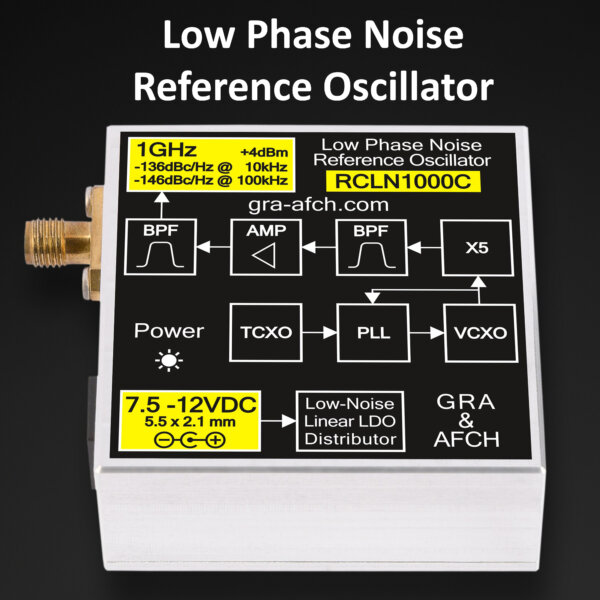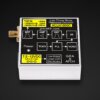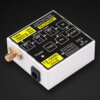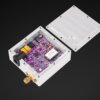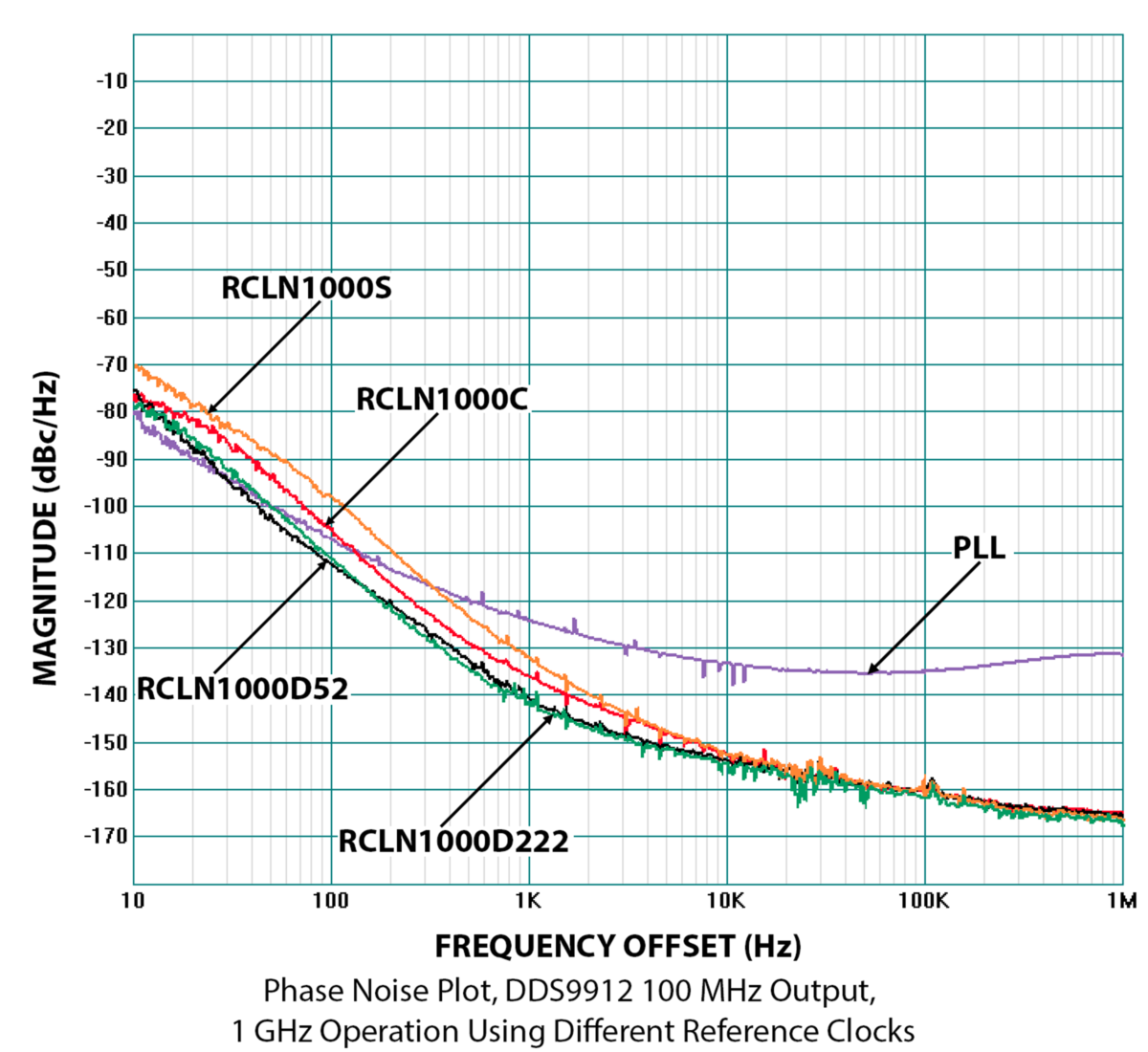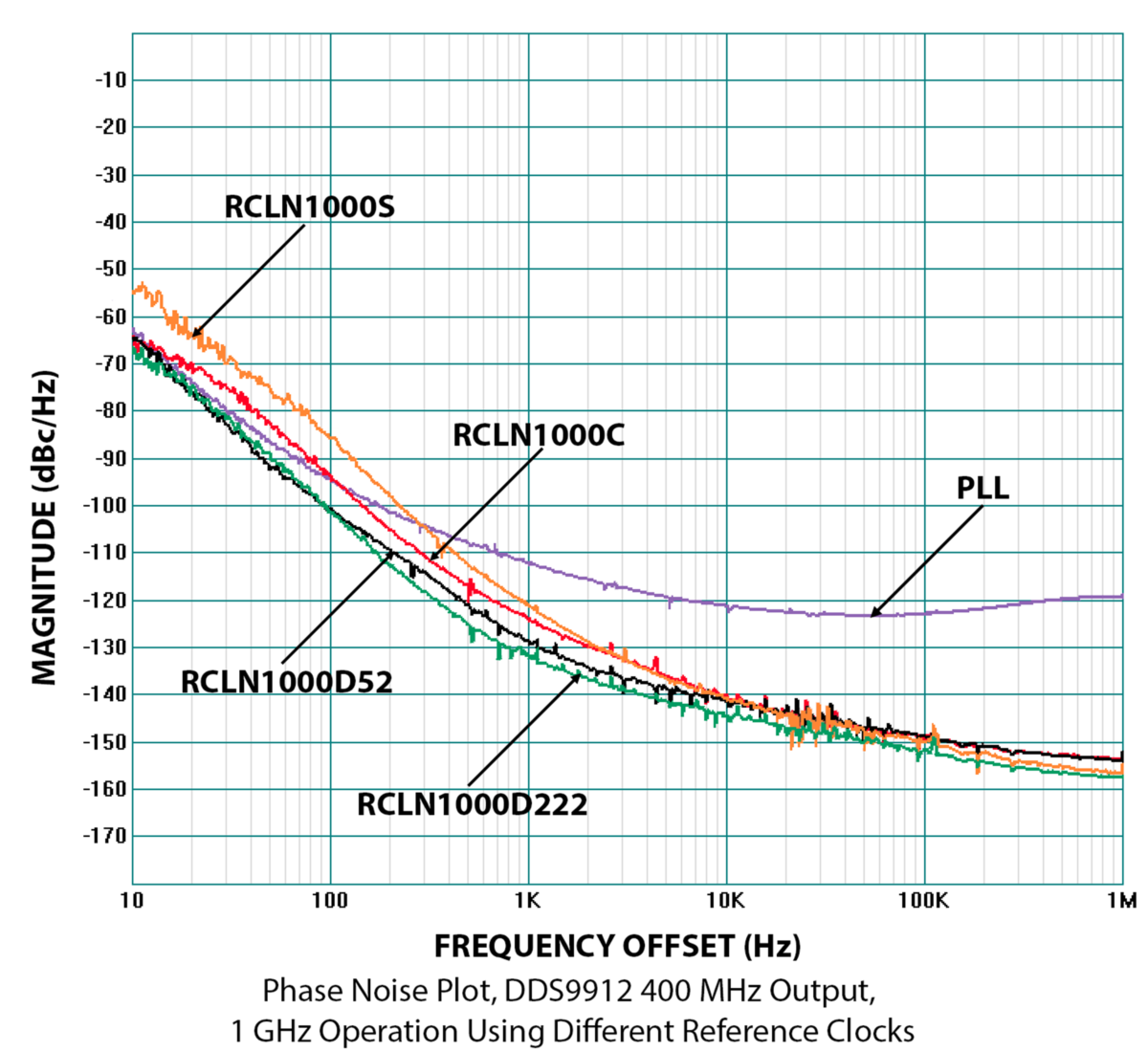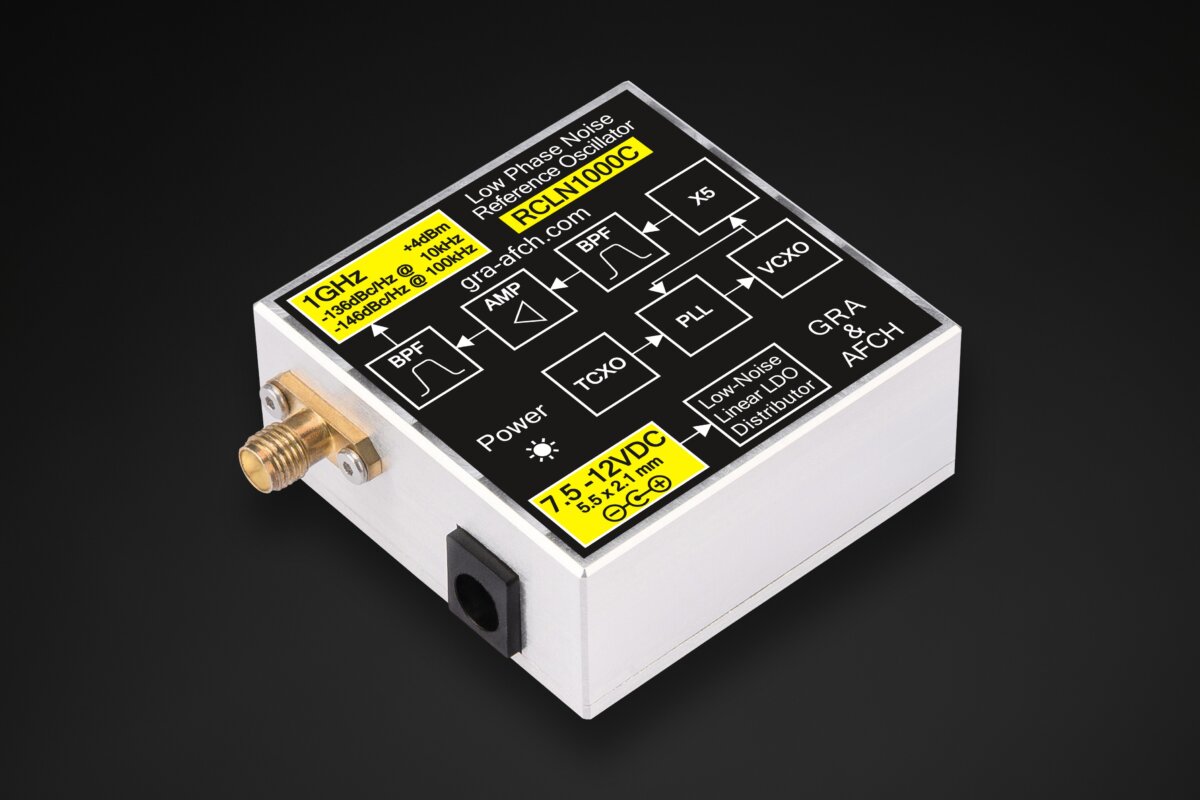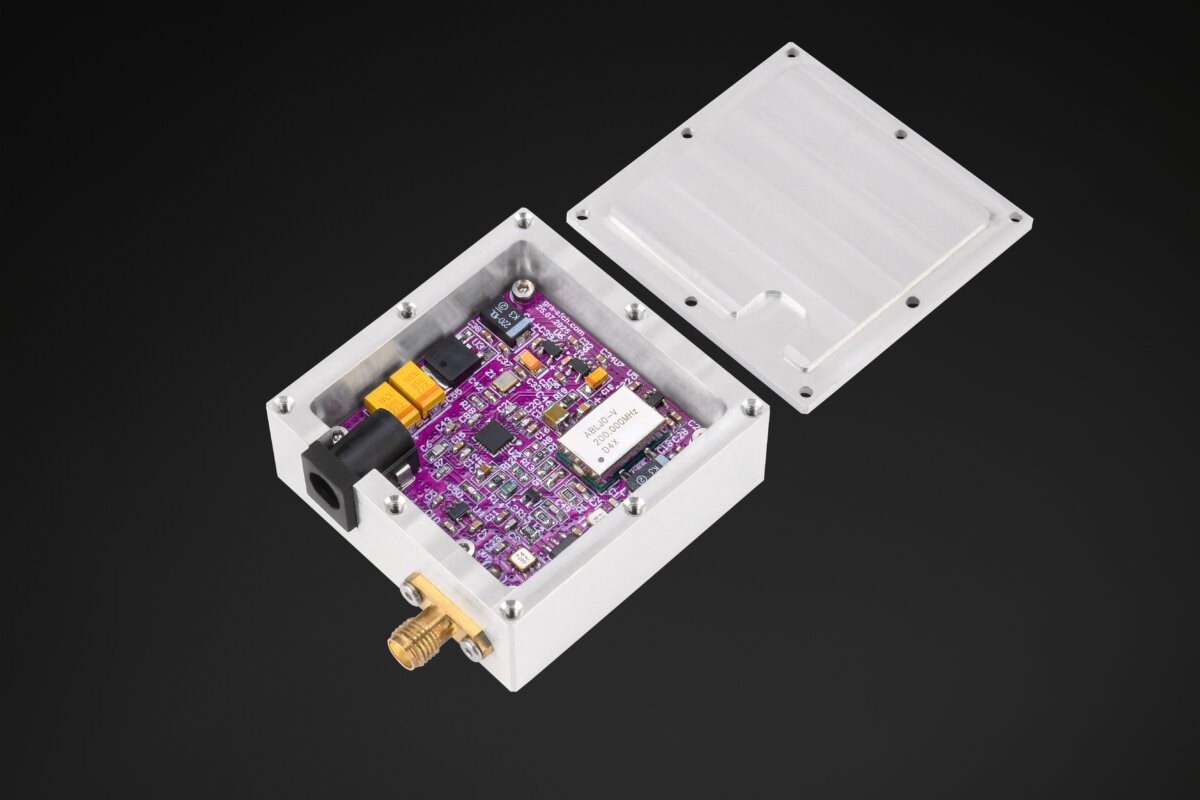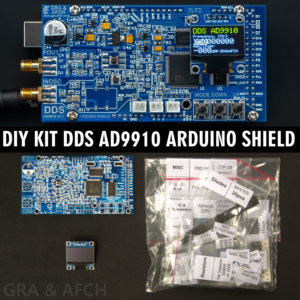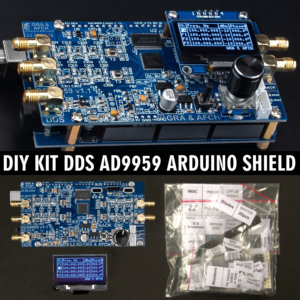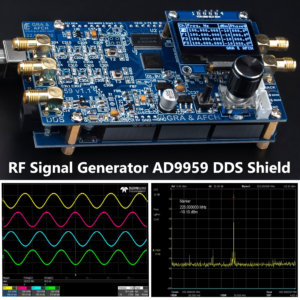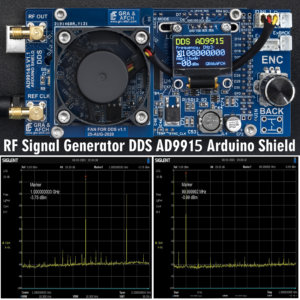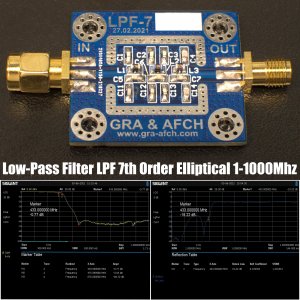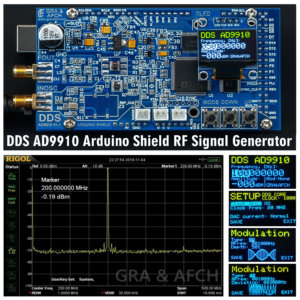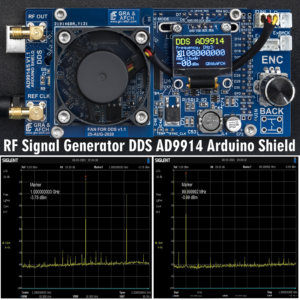RCLN1000C – 1GHz Low Phase Noise Reference Oscillator -136 dBc/Hz @ 10kHz RCLN1000C for AD9910 AD9912 Units
Units Sold: 23
The RCLN1000C Oscillator is built on a VCXO and a high-speed comparator
It generates clean rectangular CMOS signal
This approach enables precise odd-order frequency multiplication
It is implemented in this design by a factor of 5 without introducing additional phase noise
To further improve frequency accuracy the oscillator incorporates a Phase-Locked Loop (PLL)
with a Temperature-Compensated Crystal Oscillator (TCXO) as the reference
It ensuring outstanding stability and reliability across a wide temperature range
$299.95 – $314.95
1GHz Low Phase Noise Reference Oscillator -136 dBc/Hz @ 10kHz RCLN1000C for DDS AD9910 DDS9912 Units
The RCLN1000C Oscillator is built on a VCXO and a high-speed comparator
It generates clean rectangular CMOS signal
This approach enables precise odd-order frequency multiplication
It is implemented in this design by a factor of 5 without introducing additional phase noise
To further improve frequency accuracy the oscillator incorporates a Phase-Locked Loop (PLL)
with a Temperature-Compensated Crystal Oscillator (TCXO) as the reference
It ensuring outstanding stability and reliability across a wide temperature range
1 GHz Low Phase Noise Reference Oscillator
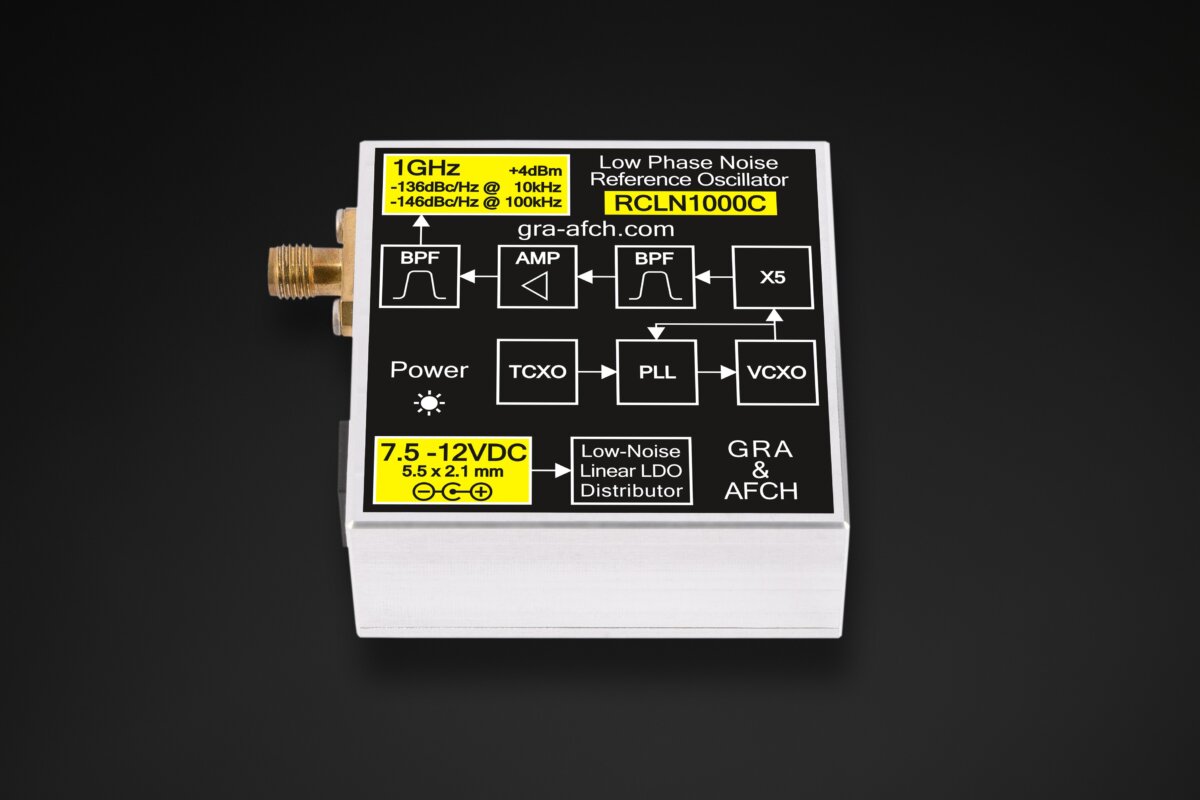
Listing includes:
- Low Phase Noise Reference Oscillator RF Unit [RCLN1000С] (1000 MHz)
- Aluminum Case [RCLN1000] (included with the Oscillator)
- Power Supply [DC 7.5V/2A] [US, EU, UK] [AC plug] (optional, choose in selector)
Custom design:
We are offering custom design development for this Unit for 1200$
This comes with condition that at least 10 pieces of them will be ordered then
If you have ANY questions, PLEASE ASK us.
General Information:
RCLN1000C is engineered as a high-performance reference source, delivering low phase noise, excellent spectral purity, and superior frequency stability.
With an affordable price, low phase noise, high temperature stability, and excellent noise immunity enabled by its thick aluminum housing
this device stands out as an excellent choice among competing products.
Ideal for use with high-speed digital and mixed-signal systems such as DDS, ADCs, DACs, and other precision RF systems.
When it comes to Direct Digital Synthesizers (DDS), the quality of the output signal is directly determined by the characteristics of the reference clock source.
In RF modules based on the AD9910, using an external low-phase-noise 1000 MHz clock oscillator provides a significant advantage over the internal PLL frequency multipliers integrated within the DDS chips.
These internal PLLs are low-cost compromise solutions — for example, the built-in PLL in AD9910 typically exhibits a phase noise of around – 129 dBc/Hz at 10 kHz offset – and they introduce a considerable amount of spurious spectral components (spurs), degrading signal purity and preventing the DDS from reaching its full performance potential. Our RCLN1000C oscillator, under the same conditions (at 1000 MHz), is capable of delivering a signal with phase noise of -142 dBc/Hz at 10 kHz offset.
Key parameters of the reference clock source include phase noise (measured in dBc/Hz, where lower is better), frequency stability (in PPM),
as well as minimal harmonic content and absence of spurious signals in the spectrum.
All of these directly affect the output quality of the DDS:
any spectral impurity or noise present in the reference clock will inevitably appear in the output signal spectrum of the synthesizer.

The pursuit of achieving the lowest possible phase noise in the oscillator inevitably leads to increased cost.
That is why we offer our customers a product line that is conditionally divided into two categories:
Base – Low Phase Noise, with typical performance in the range of approximately –136 to –139 dBc/Hz @ 10kHz offset
Premium – Ultra-Low Phase Noise, with performance in the range of –140 to –150 dBc/Hz @ 10kHz offset
Description:
The core of RCLN1000C oscillator is a specialized Voltage-Controlled Crystal Oscillator (VCXO) operating at 200 MHz with low phase noise of -150 dBc/Hz at 10 kHz offset.
While VCXOs inherently provide low phase noise, they cannot directly operate at high frequencies without external frequency multipliers. Additionally, they are susceptible to temperature-induced instability— even small temperature variations can cause significant frequency drift. To address these challenges, we implemented CMOS-comparator-based frequency multiplier with amplification using low-noise monolithic RF amplifiers. Furthermore, we integrated a Phase-Locked Loop (PLL) system with a temperature-compensated crystal oscillator (TCXO) as a reference, achieving precise frequency stabilization via feedback control. Since PLL systems naturally introduce additional phase noise, we employed an ultra-narrow loop filter bandwidth of just 10 Hz to maintain the VCXO’s low phase noise without adding extraneous noise.
For suppression of unwanted harmonics, the design employs state-of-the-art, high-quality bandpass SAW filters. Filters are placed both after the multiplier and after the amplifier, while the amplifier ensures the output signal level reaches +4 dBm.
To minimize crosstalk between internal modules, the system utilizes five independent power lines, each regulated by a low-dropout (LDO) low-noise voltage regulator, ensuring minimal phase noise and maximum signal integrity.
The 1000 MHz output frequency makes this oscillator an ideal solution for use together with the DDS9910 based on the AD9910 chip.
The block diagram of RCLN1000C oscillator is as follows:
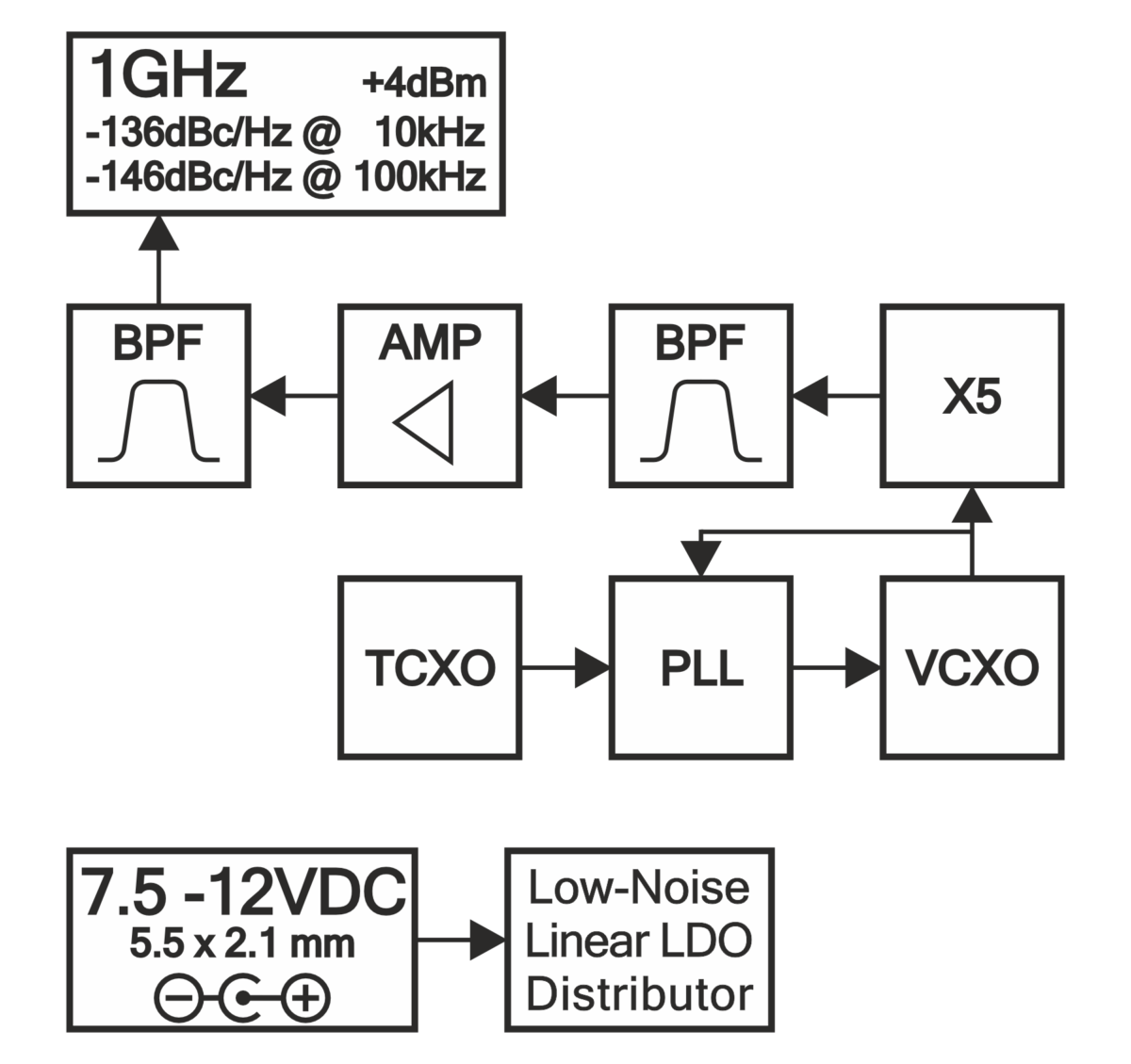
Specifications:
- 1000 MHz Fixed Frequency
- Low Phase Noise: -136 dBc/Hz @ 10 kHz
- Spurious suppression: < -48 dBc
- Output Power: +4 dBm
- Supply Voltage: 7.5…12 VDC
- Supply Current: 150 mA
- Operating Temperature: 0°C to +70°C
- Frequency Stability (0-70°С): ±0.5 ppm (±500 Hz)
- Stability per degree: 0.004 ppm/°C (4 Hz/°C)
- Case Material: Aluminum
- Dimensions: 50х50х22 mm
- Weight: 150 g
- Power Connector: 5.5×2.1 mm (+ in center)
- RF Connector: SMA
We are offering custom design development for this Unit for 1200$
This comes with condition that at least 10 pieces of them will be ordered then
Applications:
- Frequency Synthesizers (DDS)
- Local Oscillator
- Receivers
- Wireless Communications
- SATCOM
- Optical Communications
Actual Phase Noise Performance:
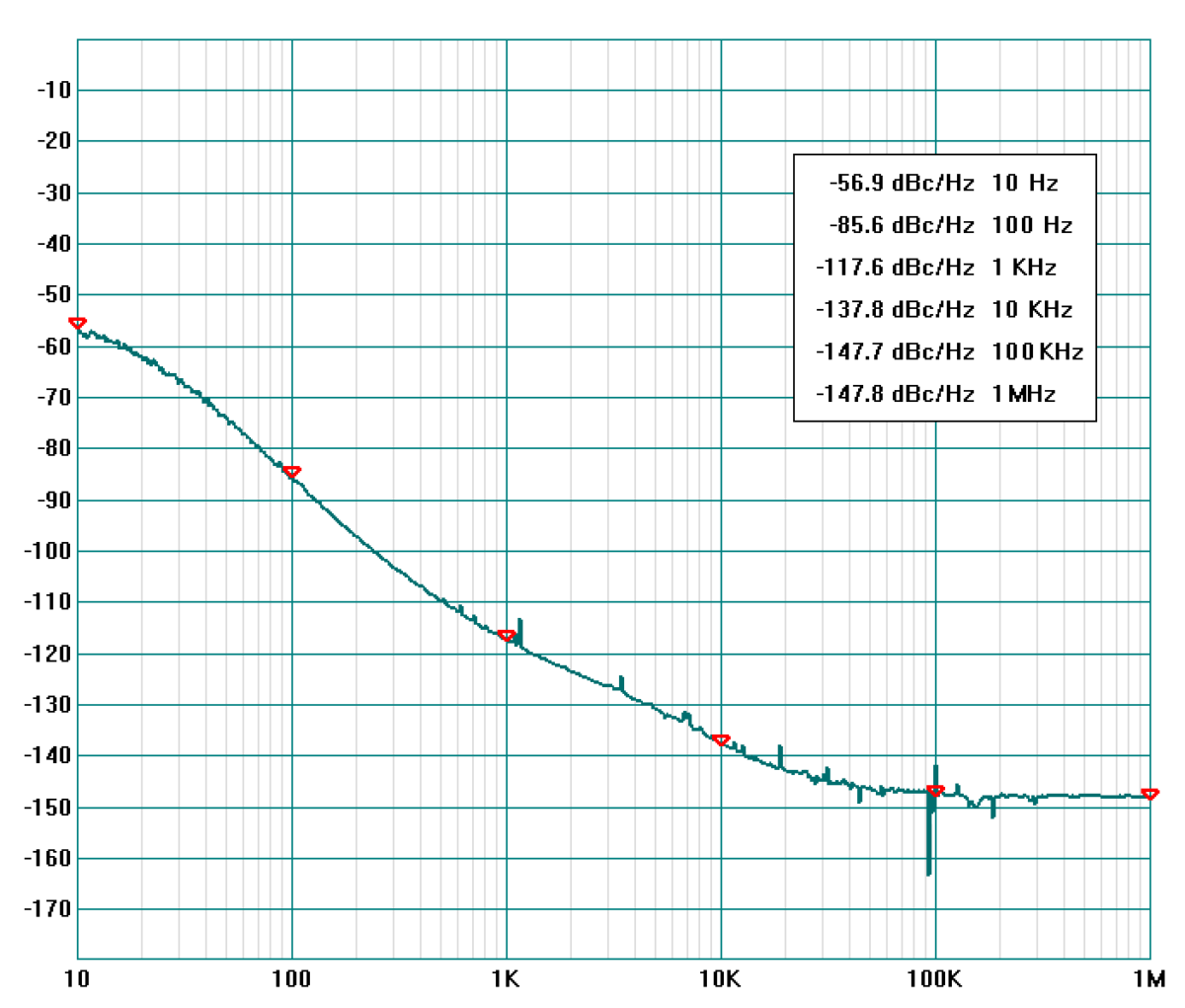
This graph demonstrates the outstanding phase noise performance of the RCLN1000C oscillator.
Starting from a 10 kHz offset, the noise level confidently drops below -138 dBc/Hz, reaching -148 dBc/Hz at a 1 MHz offset.
This confirms the exceptional signal quality and makes it a benchmark solution for the most demanding applications.
Spectrograms:
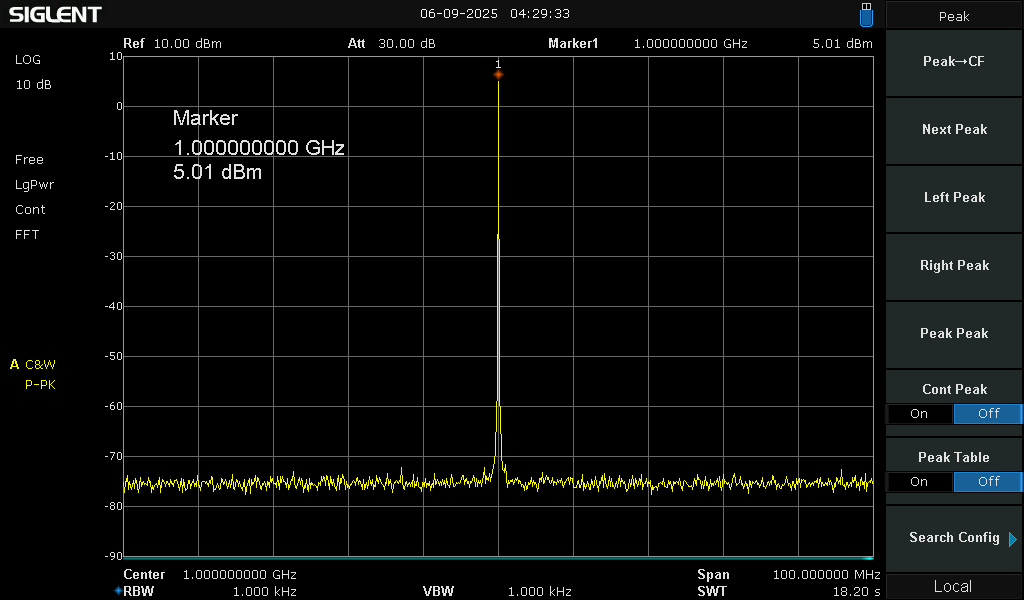
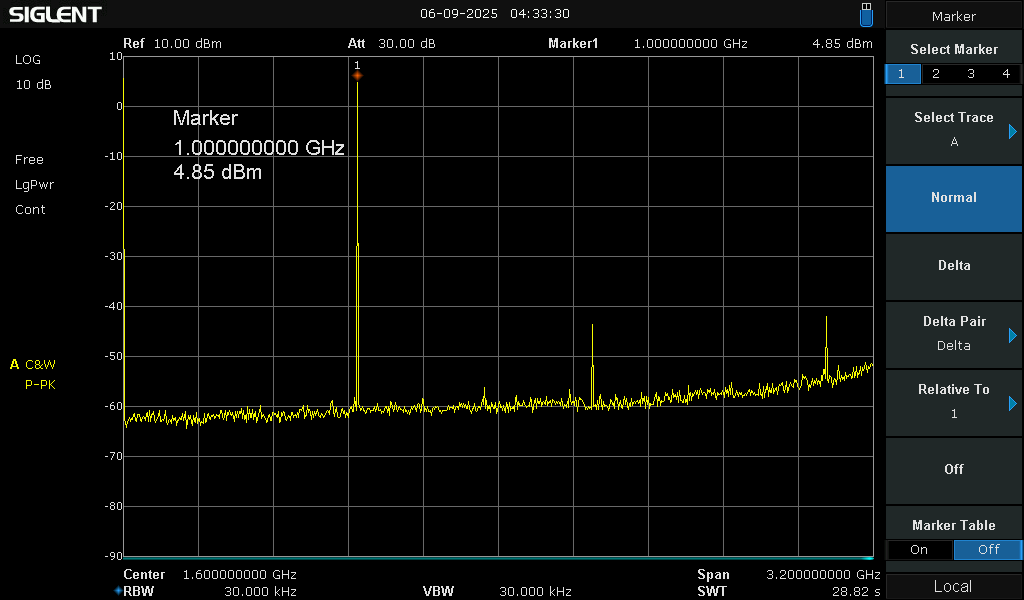
Phase Noise comparison Diagram for DDS9912 RF Unit output with RCLN Oscillators
Applications:
Telecommunications:
Low phase noise oscillators are very important for modern telecommunication systems.
They provide signal stability and accuracy under the conditions of transmitting large volumes of data.
In mobile networks and fiberoptic communication systems frequency control accuracy is needed to prevent interference and ensure high data transmission speeds.
Low phase noise allows for improved communication quality, especially in the high-frequency range, where interference can be particularly noticeable.
Radio Astronomy:
In radio astronomy low-phase noise oscillators are used in radio telescopes to enhance the quality of observations.
This allows for improved accuracy of measurements and the quality of the obtained data.
They are also used in complex systems, such as interferometers, where signals from different antennas need to be precisely synchronized.
Radar:
In radar systems low phase noise oscillators allow for improved accuracy in determining the distance to objects.
The accuracy of frequency, as well as stability and low noise level, are important when locating objects.
Lower phase noise can lead to more accurate location and identification of objects, especially at long distances.
RCLN1000C 1GHz Low Noise Reference Oscillator by GRA & AFCH:
If you have ANY questions, PLEASE ASK us.
Shipping and Return information
All Items are shipped from Ukraine
Via International registered Airmail
Shipments are made within 1 business day
After the payments are received and verified
It takes about 4-7 days via UPS Express delivery
It takes about 10-18 days via Standard shipping
It takes about 35-45 days via Economy shipping
We combine multiple Items to save on shipping
UPS Express Shipping time (recommended):
| Europe: | 3-5 days |
| Germany: | 3-5 days |
| USA, Canada: | 4-7 days |
| Asia, South America: | 5-7 days |
| Australia, New Zealand: | 5-7 days |
| Africa, Central America: | 5-7 days |
Standard Shipping time:
| Europe: | 10-12 days |
| Germany: | 10-12 days |
| USA, Canada: | 10-15 days |
| Asia, South America: | 10-18 days |
| Australia, New Zealand: | 12-18 days |
| Africa, Central America: | 12-18 days |
Economy Shipping time:
| Europe: | 25-30 days |
| Germany: | 25-30 days |
| USA, Canada: | 30-35 days |
| Asia, South America: | 35-45 days |
| Australia, New Zealand: | 45-55 days |
| Africa, Central America: | 45-55 days |
Return Policy
All Returns are accepted
- For Return you should contact Us within 14 Days after receiving the Item
- Refunds are made as Money back or Replacements (buyer’s choice)
- Return Shipments are paid by the buyer
- No restocking fees are charged
Customs Policy
We as a seller do not receive from the buyer any charges any sales taxes and handling fees.
In any case we are not responsible for Tax(VAT) or any other Import duties or any other equivalent fees that arises upon delivery.
Please consult with your local Customs legislation and visit your local Customs department or website before making any purchases.
You may also like…
DIY KIT for DDS AD9910 Shield for Arduino RF Signal Generator AM/FM/SWEEP [600 MHz, @1.5 GHz Core Clock, Low Spurs, Low Harmonic]
DIY KIT for DDS (Direct Digital Synthesis) Analog Devices AD9910 Arduino Shield
Easy connection to Arduino MEGA 2560 without additional wires and converters
For maximum performance we recommend Ultra-low noise reference oscillator RCLN1000
All functions of the DDS AD9910 are brought to the contacts of the Arduino MEGA
With this you can fully reveal all the capabilities of the DDS AD9910 Shield
PCB Design Schematics Case and Software made by GRA & AFCH$199.95 – $279.95 Select optionsDIY KIT for DDS AD9959 Arduino Shield RF Signal Generator 4 Synchronized DDS Channels [225MHz, @600 MHz Core Clock, Low Spurs, Low Harmonic]
DIY KIT for DDS (Direct Digital Synthesis) Analog Devices AD9959 4 Synchronized DDS Channels
Arduino Shield Easy connection to Arduino MEGA 2560 without additional wires and converters
All functions of the DDS AD9959 are brought to the contacts of the Arduino MEGA
With this you can fully reveal all the capabilities of the DDS AD9959 Shield
PCB, Design, Schematics, Case and Software made by GRA & AFCH$219.95 – $299.95 Select optionsDDS AD9959 Arduino Shield RF Signal Generator 4 Synchronized DDS Channels [225MHz, @600 MHz Core Clock, Low Spurs, Low Harmonic]
DDS (Direct Digital Synthesis) Analog Devices AD9959 4 Synchronized DDS Channels
Arduino Shield Easy connection to Arduino MEGA 2560 without additional wires and converters
All functions of the DDS AD9959 are brought to the contacts of the Arduino MEGA
With this you can fully reveal all the capabilities of the DDS AD9959 Shield
PCB, Design, Schematics, Case and Software made by GRA & AFCH$189.95 – $269.95 Select optionsDDS AD9915 Arduino Shield RF Signal Generator [1GHz @3GHz Core Clock, Low Spurs, Low Harmonic]
DDS (Direct Digital Synthesis) Analog Devices AD9915
Arduino Shield Easy connection to Arduino MEGA 2560 without additional wires and converters
All functions of the DDS AD9915 are brought to the contacts of the Arduino MEGA
With this you can fully reveal all the capabilities of the DDS AD9915 Shield
PCB, Design, Schematics, Case and Software made by GRA & AFCH$599.95 – $679.95 Select optionsLow-Pass Filter LPF 7th Order Elliptical 1-1000Mhz 3.5, 7, 14, 28, 144, 433MHz etc for RF Amlifier, Receiver, Transmitter, Mixer, Transceiver, Antenna.
Low-pass Filter is a filter that passes signals with a frequency lower than a selected cutoff frequency
It than also attenuates signals with frequencies higher than the cutoff frequency
These filters are usually applied after RF amplifiers like MMIC, Gain-block and Class C amplifiers
It is used for suppression of high-order harmonics of radio-frequency signals
They can also be placed at the mixer output to filter high frequency interference that plays a role in frequency selection$18.95 – $69.95 Select optionsDDS AD9910 v2 Shield for Arduino RF Signal Generator AM/FM/SWEEP [600 MHz, @1.5 GHz Core Clock, Low Spurs, Low Harmonic]
DDS (Direct Digital Synthesis) Analog Devices AD9910 Shield for Arduino
This device is designed to ensure seamless integration with Arduino MEGA 2560
It does not require any extra wires or converters to work properly
For maximum performance we recommend Ultra-low noise reference oscillator RCLN1000
All functions of the DDS AD9910 are brought to the contacts from the Arduino MEGA
With this you can fully reveal all the capabilities of the DDS AD9910 Shield
PCB Design Schematics Case and Software made by GRA & AFCH$209.95 – $289.95 Select optionsDDS AD9914 Arduino Shield RF Signal Generator [1.4GHz @3.5GHz Core Clock, Low Spurs, Low Harmonic]
DDS (Direct Digital Synthesis) Analog Devices AD9914
Arduino Shield Easy connection to Arduino MEGA 2560 without additional wires and converters
All functions of the DDS AD9914 are brought to the contacts of the Arduino MEGA
With this you can fully reveal all the capabilities of the DDS AD9914 Shield
PCB, Design, Schematics, Case and Software made by GRA & AFCH$699.95 – $904.95 Select options


